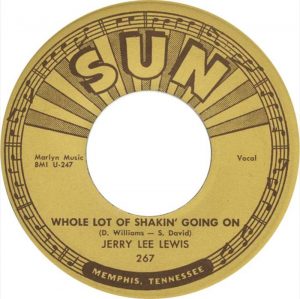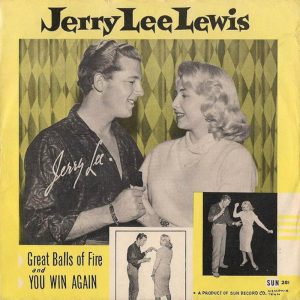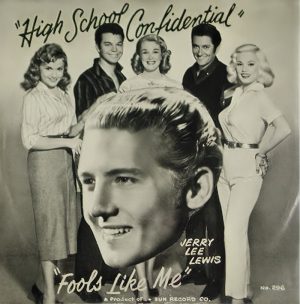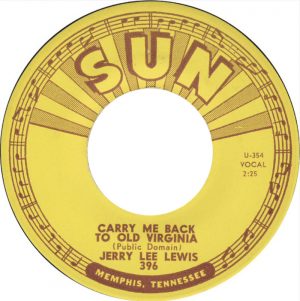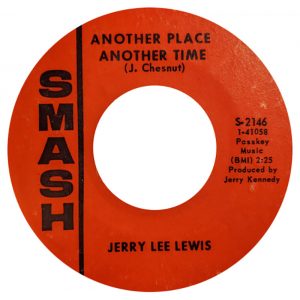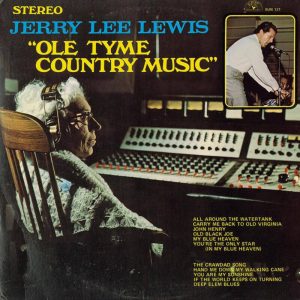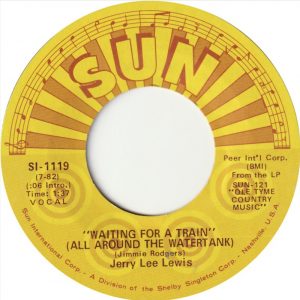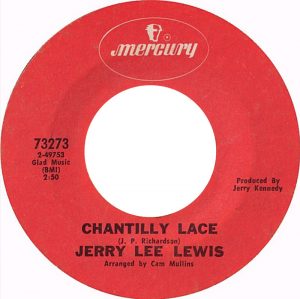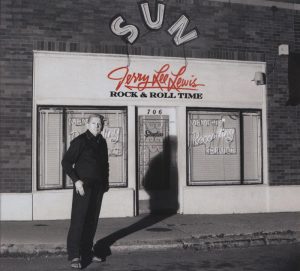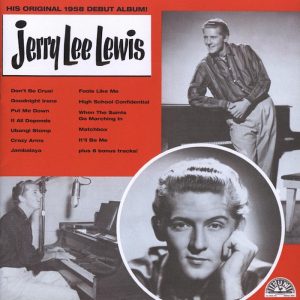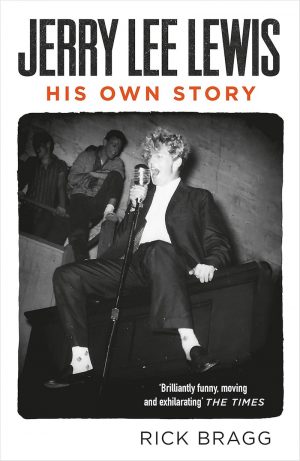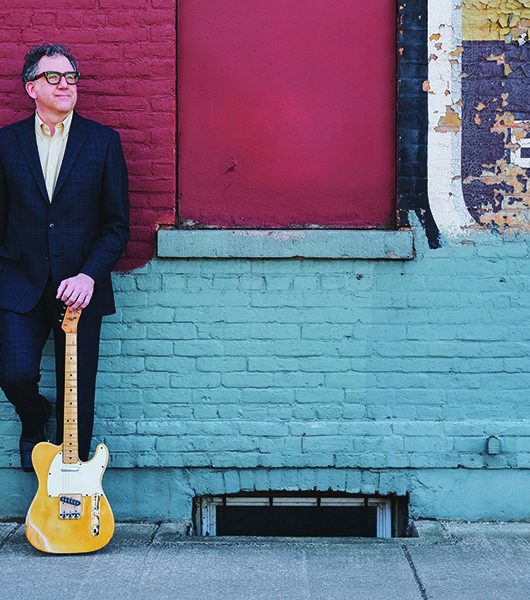In our Lowdown on Jerry Lee Lewis we explore how The Killer’s piano-pounding career lasted for more than 70 years…
In 2006, Jerry Lee Lewis released Last Man Standing, a CD of duets with artists including B.B. King, George Jones, Mick Jagger and Willie Nelson. It soon became his best-selling album. But although Lewis had outlived Sun Records cohorts Elvis Presley, Johnny Cash, Roy Orbison and Carl Perkins, the title was a red herring because other original rock and rollers such as Chuck Berry, Fats Domino, Little Richard, The Everly Brothers and Bo Diddley were still with us. Sadly, by the time of Lewis’ passing in 2022, the reference was more apt. But Lewis was 87, not bad for a man who in 1981 had been hospitalised with a ruptured stomach and collapsed lung, and for some time after looked so gaunt and sickly few believed he’d make it to 50.
If Gene Vincent was the archetypal scary rocker, Jerry Lee Lewis, aka The Killer, ran him pretty close. Anyone who experienced Jerry Lee eyeballing the audience as he sat at an angle to his piano while still singing and pounding away would testify to his extraordinary, maybe unparalleled, stage presence. But while there was something otherworldly about Vincent, despite his religious training and self-conflict about playing “the Devil’s music”, Jerry Lee was a more self-possessed character.
It was this that kept him bouncing back after personal and professional disasters. Even near the end, a stroke-ridden Lewis, distressingly frail, was still working and cut a gospel album with his cousin, Jimmy Swaggart (The Boys From Ferriday).
Prickly Persona
As a self-proclaimed stylist, his range was wide, albeit always invested with his personal signature.
His catalogue is arguably the most interesting of the first-generation rockers and his scandal-ridden prickly persona made him off limits for the mainstream, but it gave his music an added edge. His live shows remained consistent to his roots, varying only in the quota of country songs he was minded to sing on a given night. The visual image projected live and on record covers was more varied. Sun Records’ ferrety-eyed, blond Ferriday Fireball often slicked the hair back and got suited up like a bank executive in the 1960s. There was a bearded phase, and a bomber-jacketed rocker get-up. Cigars were a popular prop, and in middle age he favoured the dignified antebellum gent look. He finally wound up as the grand old man of rock, still with the wavy hair and rascally lopsided grin intact.
As Old Father Time took a grip, Jerry Lee looked like a benign old boy, but still a fascinating character.
Rick Bragg recounted to this writer that when he visited him to work on his autobiography (Jerry Lee Lewis: His Own Story) in the summers of 2011 and 2012, Lewis had shown him his brushed steel Magnum revolver, “just so I knew he had it under his pillow.” The Killer had mellowed, but not that much.
KEY SONGS
Whole Lotta Shakin’ Going On
The song that set the tone for a career. Others recorded it, but Lewis’ 1957 Sun waxing transformed the song into a lascivious rocker without clear precedent, although the saucy “wiggle it around” spoken part was said to be lifted from a Natchez singer’s performance. It’s not a boogie or R&B, nor is it rockabilly or rock’n’roll by any straight reading, in the same way Lewis defied pigeonholing.
Great Balls Of Fire
Jerry Lee’s biggest seller, the follow-up to Whole Lotta Shakin’ and vying with it as his most famous number. Again, impossible to categorise. It has an obvious boogie root, and there’s no guitar. Jerry Lee’s vocal surfs above the interplay of his piano and J.M. Van Eaton’s drums. Allied to the stop-start rhythm, the effect created is akin to being on an exhilarating rollercoaster. It gave Lewis his highest US placing of No.2 in 1957.
High School Confidential
The intro to this racing rocker is pure Jerry Lee. “Open up a-honey it’s your lover boy me that’s a-knocking,” he sings. He simulates three knocking sounds on piano, except it sounds like a boot that’s being applied to his girl’s door. Written for the teen film of the same name, Roland Janes’ guitar riff rings like a school bell. But Lewis builds such excitement that by Janes’ solo the delinquents are in charge.
Carry Me Back To Old Virginia
Lewis’ final Sun 45, though by the time it came out in 1965, he’d been signed to Smash for two years. He recorded it in 1963 at his last Sun session where Sam Phillips was experimenting with a bigger sound. The song has a long, vamping intro. Lewis sings soulfully over a churchy backing chorus, transforming an old chestnut from the 19th century into a red hot slice of contemporary R&B.
Another Place, Another Time
Lewis cut this in 1968, with some reluctance at first, probably as he’d heard Del Reeves making a dog’s dinner of it the previous year. Jerry Lee nailed it in two takes. He was always a country singer, but this was something else, capturing the suffocating sadness of a man in a bar near closing time, brooding over lost love while watching lights going out “one by one”. It sparked Lewis’ country renaissance.
The Crawdad Song
The depth of Lewis’ greatness became fully apparent when Shelby Singleton bought the Sun catalogue in 1969 and began releasing unheard material in a somewhat haphazard fashion. This overlooked gem was first heard on Ole Tyme Country Music in 1970. Here’s Lewis, J.M. Van Eaton and Roland Janes whooping it up at the end of 1956 on an obscure country-folk number. The loose synchronicity these three had was uncanny.
Waiting For A Train (All Around The Watertank)
“Country music, rock music, blues music, started from the old blue yodeller Jimmie Rodgers, who was born in Meridian, Mississippi… and this is the king that started it,” said Jerry Lee, waving a finger when Dick Cavett mocked yodelling while he was on Cavett’s talk show. Lewis’ love for Rodgers was plain in several recordings of this song, one of them making US Country No.11.
Chantilly Lace
By 1972 Lewis was getting into a country rut, the honky tonk seam feeling played out. Chantilly Lace returned him to old 50s hunting grounds. Revisiting The Big Bopper’s cheeky, much-loved novelty song suited Lewis’ Louisiana drawl. Many have criticised the over-cooked Jerry Kennedy production, but it cut through, topping the US Country Chart, and giving Lewis his first (and final) entry in the UK (No.33) for nine years.
Number One Lovin’ Man
Between 1979 and 1980 Lewis had a creative album flurry with Elektra. The first LP, Jerry Lee Lewis (1979), produced by Bones Howe in L.A., is one of his most satisfying, suggesting a revitalised artist, returning to his rockin’ roots albeit via a heavier beat. Rockin’ My Life Away was a Killer thriller, but it was Number One Lovin’ Man that really blazed, majorly helped by James Burton’s scorching solo.
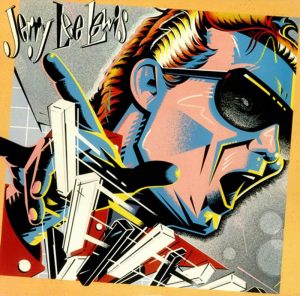 Promised Land
Promised Land
Although Lewis’ latter-day duet albums sold well, few fans count them among their favourites, due to the inevitable clash of styles and dilution of The Killer’s spirit. Rock & Roll Time (2014) was the last of the big-name collaborations, guests including Neil Young, Keith Richards and Robbie Robertson. At least Lewis was granted space to rattle through the closer, Chuck Berry’s Promised Land, in the familiar take-no-prisoners style of old.
KEY ALBUMS
Despite emerging from the singles-oriented Sun label, the Ferriday Fireball also became a fine album artist…
The two albums released while at Sun Records, Jerry Lee Lewis (1958), and 1961’s Jerry Lee’s Greatest! show that, as well as being a seminal piano-playing rock and roller, he could put his personal stamp on the work of other accomplished artists such as Ray Charles, Ray Price and Hank Williams.
The Smash albums from the mid-60s were tame by comparison, though The Return Of Rock (1965) had thumping readings of Corine, Corina and You Went Back On Your Word. Live At The Star Club, Hamburg (1964), The Greatest Live Show On Earth (1964) and By Request: More From The Greatest Live Show On Earth (1966), the latter pair issued on double vinyl in 1978, are unimprovable statements of the energy of his stage show.
Killer Catalogue
In the late 1960s Lewis enjoyed a comeback as a country singer, with the albums Another Place, Another Time (1968) and 1970’s She Even Woke Me Up To Say Goodbye the best from this period.
The three LPs made for Elektra between 1979 and 1980, Jerry Lee Lewis, When Two Worlds Collide and Killer Country, are good value latter-day Lewis, the first being the best. Despite an unappealing sound mix, Young Blood (1995) was really the final roar of the lion, solo album-wise, with decent rockers such as Crown Victoria Custom ’51 and Down The Road A Piece.
Some of the Sun back catalogue compilations from Shelby Singleton, containing much unheard material, were revelatory at the time, among them being Ole Tyme Country Music (1970) and Original Golden Hits Vol. III (1971).
Of emotional and historical value is 1978’s The Essential Jerry Lee Lewis – 20 Original Rock’n’Roll Hits. Tracks were chosen by the late Barrie Gamblin, who ran the UK arm of Jerry Lee’s fan club, distributing the magazine Fire-Ball Mail, a treasure trove of information for fans. Teddy Boy Waxie Maxie’s sleevenotes capture Jerry Lee exactly as he came across to adoring audiences.
JERRY LEE ON FILM
Film cannot convey the magnetism of Jerry Lee to anyone who never saw him play live on one of his ‘on’ nights, but it can help. Movie appearances included the unloved musical Jamboree (1957), performing Great Balls Of Fire, and the Jack Arnold-directed High School Confidential! (1958), a teenage ‘problem’ flick (“a world your own kids will never tell you about” ran the trailers) starring Mamie Van Doren and Russ Tamblyn, in which Lewis sang the title track from a truck.
He appeared as himself, along with fellow rockers Chuck Berry, Frankie Ford and Screamin’ Jay Hawkins, in American Hot Wax (1978), a biopic portraying the rise and fall of the pioneering DJ Alan Freed.
His own biopic, Great Balls Of Fire! (1989), in which he was played by an over-the-top Dennis Quaid, and for which he recorded the soundtrack, wasn’t a success.
ESSENTIAL READING
Although Nick Tosches’ Hellfire: The Jerry Lee Lewis Story (1982) was a stylistic landmark among rock’n’roll biographies, it’s not for those who prefer music writing with fewer flights of overblown prose. The book played to The Killer legend. Much of it can’t be taken as gospel. As Jimmy Guterman wrote in his superb Rockin’ My Life Away: Listening To Jerry Lee Lewis (1991), “People get so high on the myth of Jerry Lee that often many forget that the guy sings and plays piano.” Guterman doesn’t downplay the outrageousness or impetuousness of Lewis, but his book is the one to go to for an insight into the music.
Ostensibly an autobiography, Jerry Lee Lewis: His Own Story (2014) was written by Alabama-born Rick Bragg and beautifully described the brooding atmosphere of the American Old South of the star’s childhood. A fascinating insight into a contradictory character looking back on a helter-skelter life. Peter Checksfield’s authoritative Jerry Lewis: Breathless! Every Song From Every Session, 1952-2022 (2023), brims with interesting facts, a must-read for all Jerry Lee Lewis musos.
THE SUN SOUND
The Killer is sometimes referred to as one of the Southern rockabillies, but from a purist angle his records aren’t straight rockabilly. Making his piano the lead instrument and lacking a prominent string bass immediately gave him a different sound. His boogie-rooted playing gave him a different rhythm. An inspiration for Lewis’ piano-pounding approach was said to be Moon Mullican, the so-called ‘King Of The Hillbilly Piano Players’, whose rollicking barrelhouse boogie and Cajun flavourings had clear links with the music of Black juke joints.
Yet Lewis’ vocals had a rockabilly intensity, especially given Sun’s echo. Who can deny tracks like Wild One (Real Wild Child) aren’t rockabilly in spirit? Jerry Lee’s tracks had the spontaneous feel of rockabilly, even if more work went into them than is often assumed. When Bear Family Records released its 18CD Jerry Lee Lewis At Sun Records: The Collected Works (2015), it included over 20 takes of High School Confidential.
Who’s Gonna Play This Ol’ Piana
Lewis claimed he never sang a song the same way twice, and Sam Phillips quickly worked out he was an artist best given as free a rein as possible.
At Sun, key collaborators were Roland Janes on guitar and J.M. Van Eaton on drums. Janes and Van Eaton were perceptive characters and their contributions to Lewis’ Memphis sound cannot be overstated. Janes has tended to be overshadowed by bigger names such as Scotty Moore, Cliff Gallup, Joe Maphis and James Burton. His solos were often short and to the point, but his ringing, almost siren-like sound can be heard to good effect on Whole Lotta Shakin’, High School Confidential and End Of The Road through to obscurities including Deep Elem Blues.
Van Eaton was resolute in his belief that a session man’s job was to help make the headline artist sound as good they could. He had a lighter touch than many rock drummers but spoke with pride of the rhythm he’d get on the ride cymbal to match Lewis’ playing. He felt it created a swinging effect slightly different from the shuffle rhythm popular at the time, and gave the effect of the drum sound seeming to rest on top of the beat rather than beneath it.
For more on Jerry Lee Lewis click here
Read More: Top 40 Essential Jerry Lee Lewis


